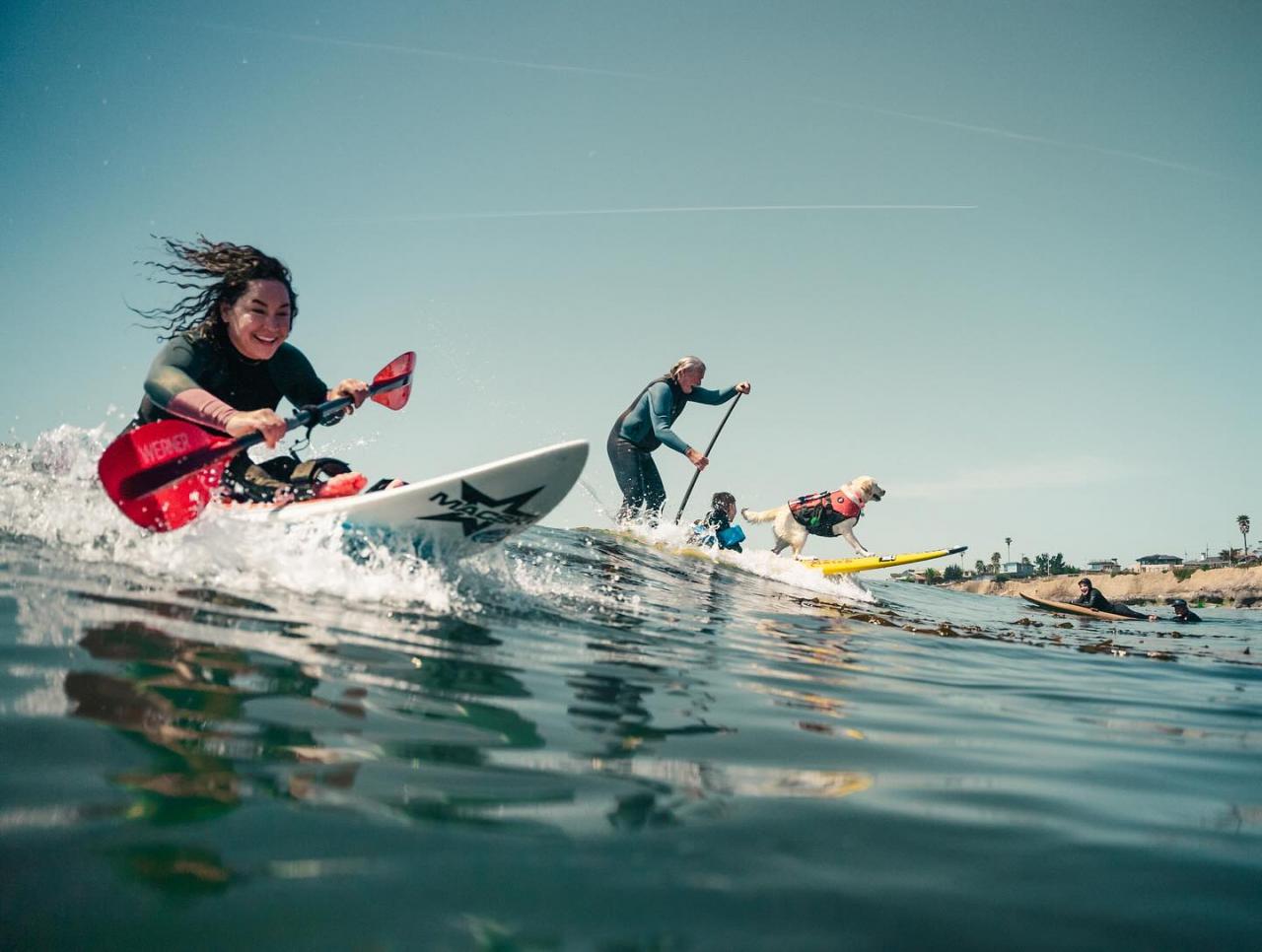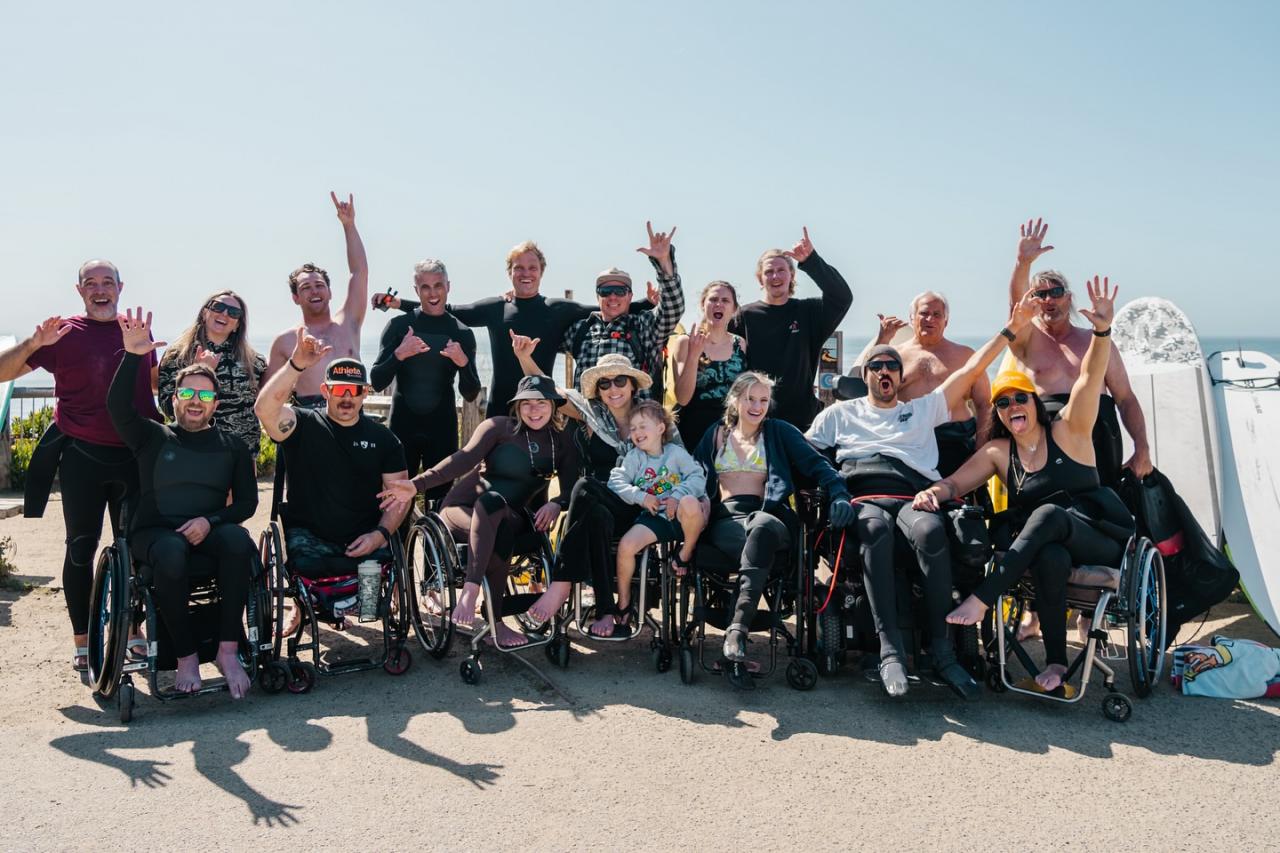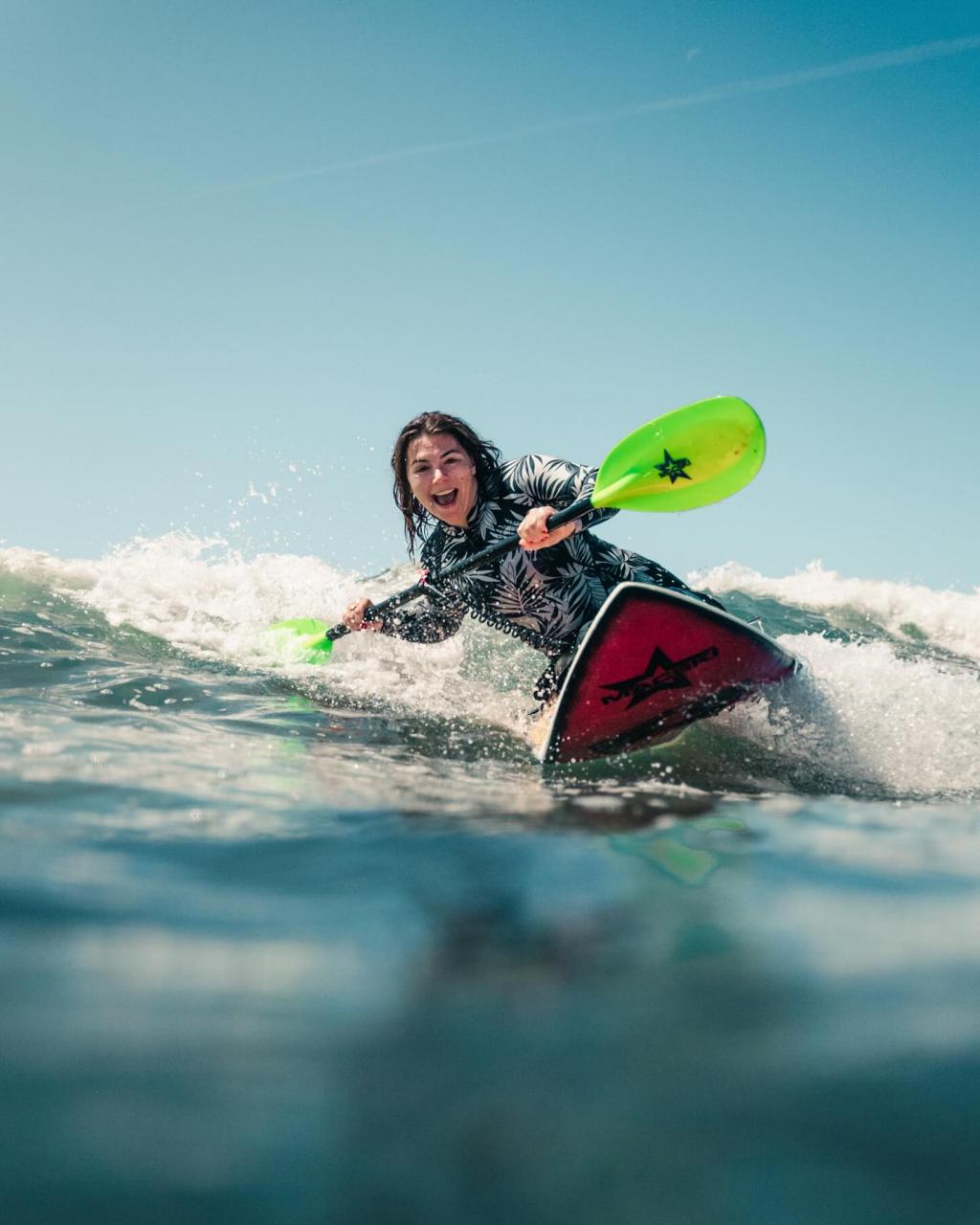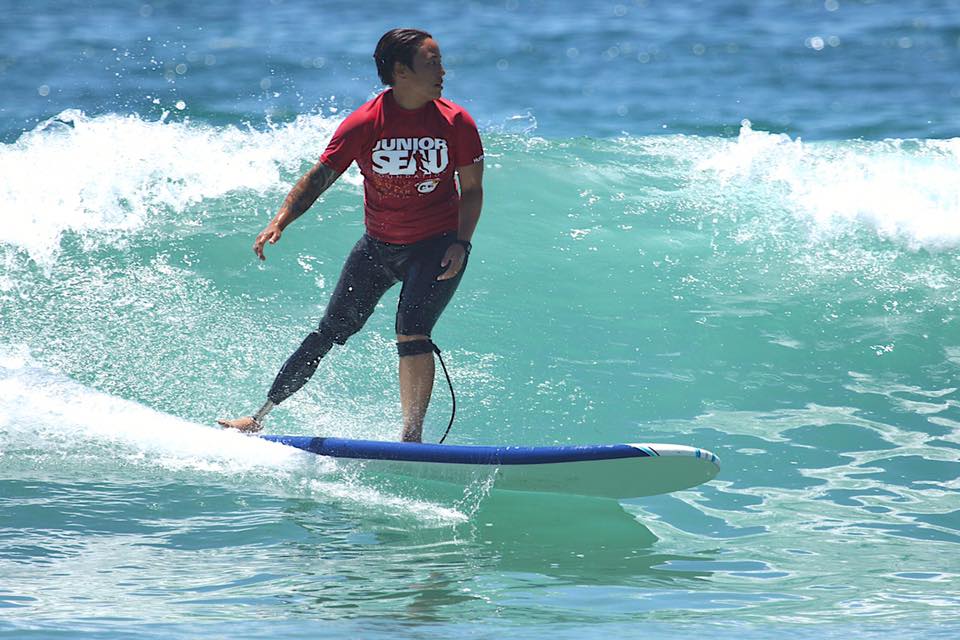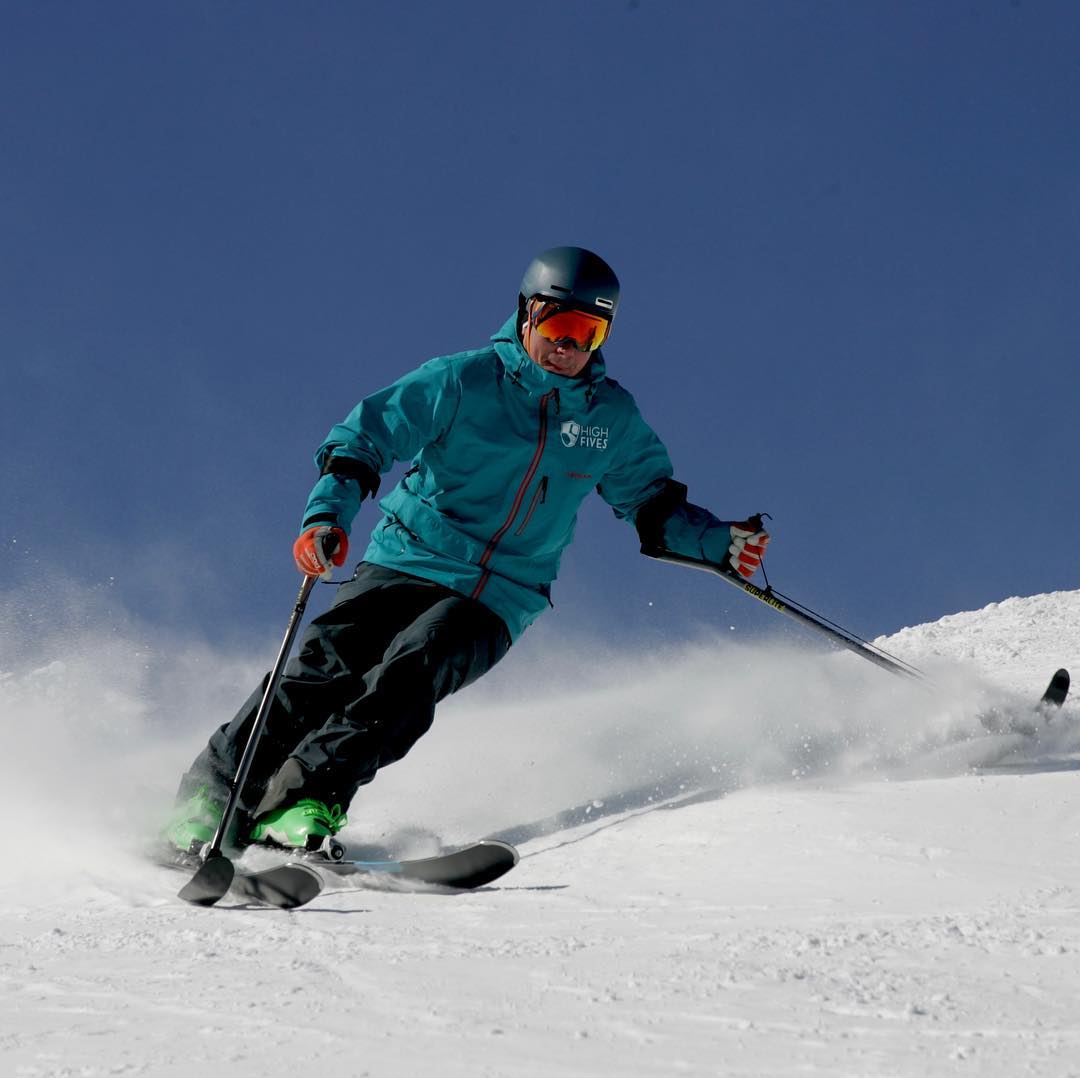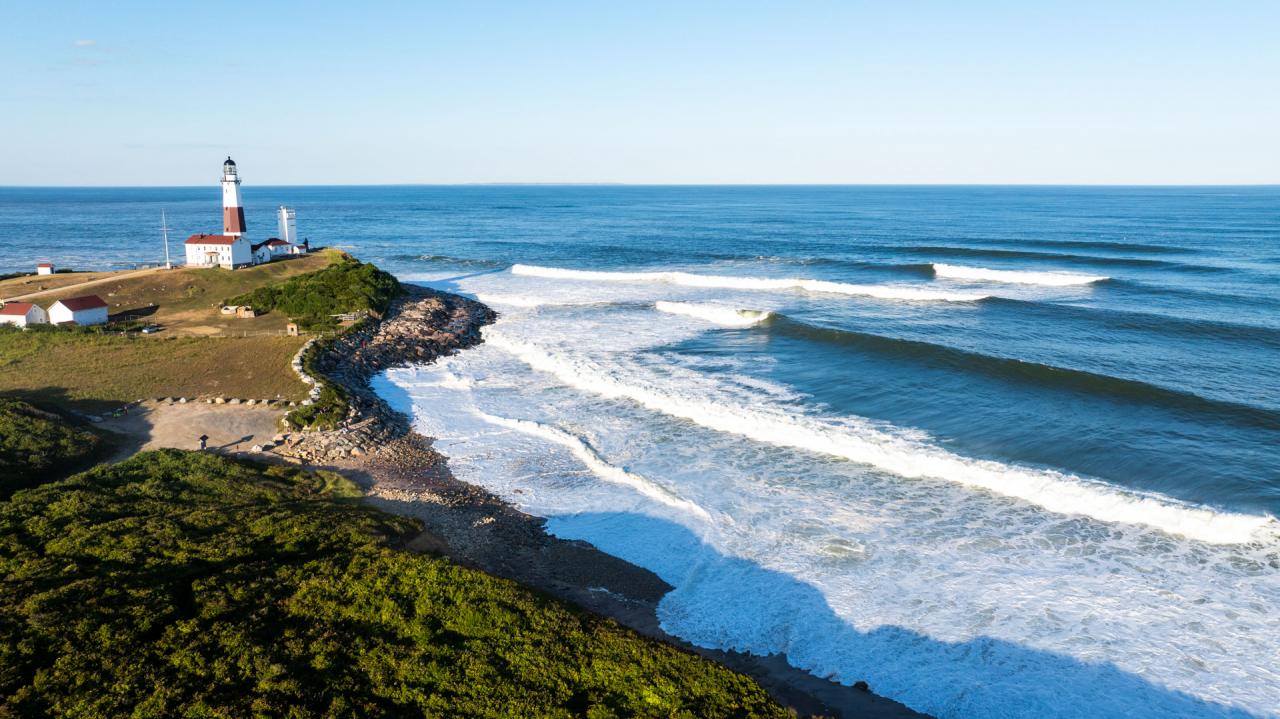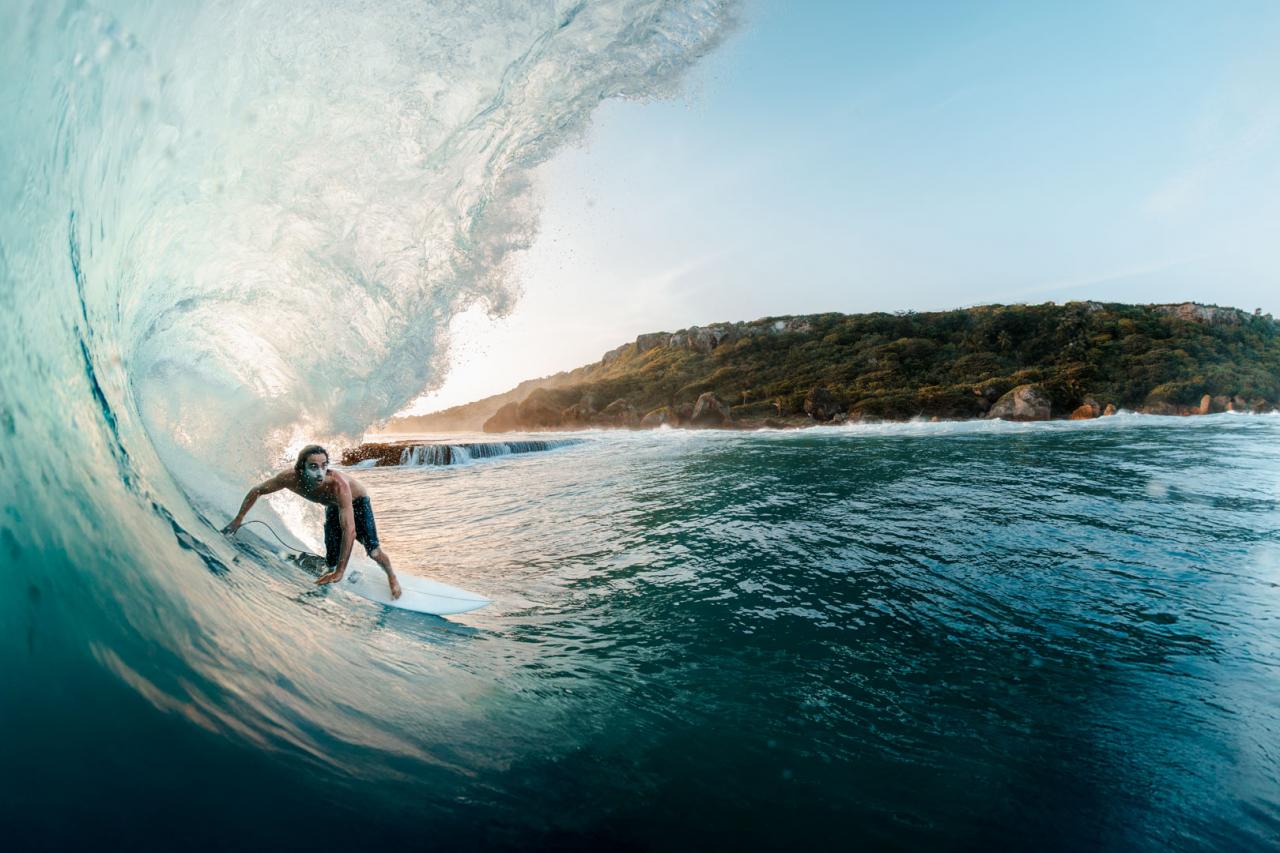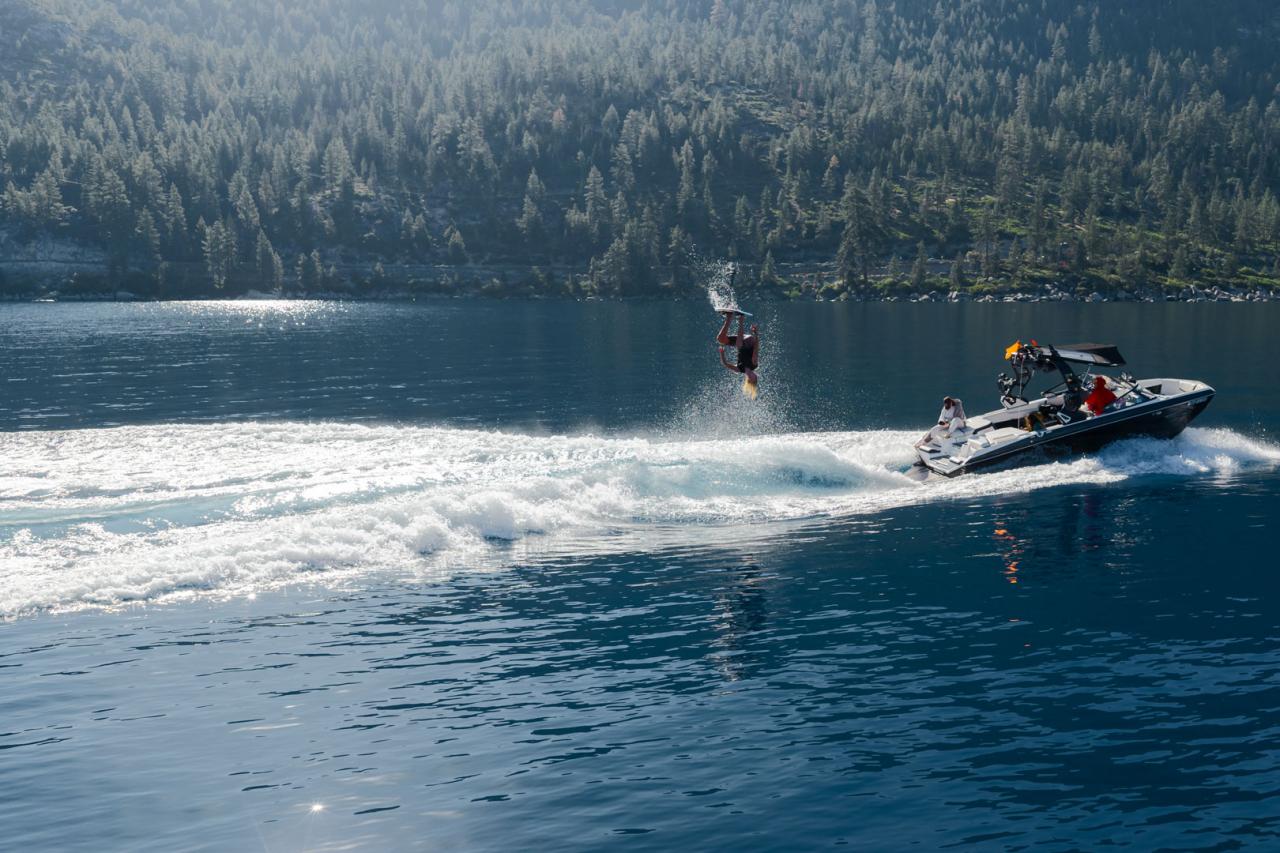“Whether you just like to surf or want to compete, those are all options that High Fives Foundation provides. But most importantly, it’s about creating a place where you belong. Feeling like you belong somewhere is the most important part.” – Alana Nichols
As winter melts into spring each year, the staff and athletes of High Fives Foundation travel south from Lake Tahoe, California to Santa Cruz for one of their annual adaptive surf camps. Participants paddle out at a mellow break below Jack O’Neill’s house where the biggest hassle of the day for most people is trying not to get a hand stuck in a mass of seaweed with every paddle.
“Yep, that’s an indication that the ocean is alive and well,” laughs Rob Jarvis as I flick a tangle of kelp off my wrist. Rob’s a local surf legend who has lived in Santa Cruz for more than 30 years, and he’s been a beloved waterman for High Fives since 2015, overseeing many adaptive surf camps. Little did I know, Rob had driven five hours from Reno, Nevada to Pleasure Point yesterday on a moment’s notice just to meet me for a two-hour surf session in sub-par conditions this morning. I’m shocked when he mentions this in conversation between sets, worrying that I had totally inconvenienced him, but instead he gives me an easy smile. “When High Fives calls,” he says, “I answer.”
High Fives Foundation is a nonprofit organization headquartered in Truckee, CA. Founded in 2009 by Roy Tuscany to pay it forward after a serious spinal cord injury, High Fives has helped more than 750 athletes and veterans improve their overall health and return to the sports they love, or discover new ones, after a life-changing injury. More than 70% of these individuals have sustained a spinal cord injury. Some have traumatic brain injuries, some have had limbs amputated, and many have survived a combination of multiple serious injuries all at once. What started as a foundation focused on winter sports has expanded across the country and evolved to encompass five main pillars of adaptive sport: surfing, skiing/snowboarding, mountain biking, motor-fed sports, and fly fishing.
Outdoor sports enthusiasts know that there is inherent risk in the sports we love. Even just going out for a walk, there’s some level of risk involved. Accidents happen. So, what if your identity is tied to a sport that you love, and a doctor tells you you’re never going to be able to do it again?
You find a way to return to the activities that make you feel alive, surrounded by a team of people who will keep you safe and supported. That’s where High Fives Foundation comes in.
“When High Fives established the surfing experience as one of their pillars, they were going to do it right and create a full experience that includes water safety,” says Alana Nichols. “It makes all the difference, especially when you’re learning to surf. If you don’t feel safe out there, you’re not going to be able to really enjoy it.”
So, how did surfing become a pillar of sport for High Fives Foundation? One perspective Roy Tuscany shares is the sense of freedom that comes with being in the water, especially for individuals who use a wheelchair. “Even on really big surf days, you can still go out to the break and sit in the ocean with your friends with no adaptive devices and really feel free,” says Roy.
Roy is the founder and CEO of High Fives Foundation. Under his leadership, the surf program has grown from one camp for six athletes in 2012 to five camps for 60+ athletes in 2023. To date, High Fives has helped more than 200 athletes experience the restorative powers of surfing.
“We were open to following this concept of why should this work?” shares Roy. “Well, it’ll work because we’re able to do the following—try new sports, figure out how to partner with folks that are experts in the field, and grow a very inclusive way for people to enjoy their time with others.”
“Surfing feels really inclusive,” Roy continues. “There’s a lot of adaptations that have made it become more inclusive. It’s opened up a lot of different styles of surfing, and those different styles of surfing have their own way of being a voice to that individual.” Nowadays, you can adapt to any need for surfing—examples include laying prone, sitting, kneeling, or using a prosthetic to stand on a board. “It’s showcasing that we are all surfers,” says Roy. “At the end of the day, each person is looking to carve a turn on the face of a wave, and it really doesn’t matter how that person is set up as long as it is a way that works for them.”
“I tend to tell people the ocean is very healing,” says waterman Rob Jarvis. “It’s an equalizer. When you’re in the water, whether you have all your arms and legs or whether you don’t, it treats everybody the same.”
Expanding on the motivation to incorporate surfing through High Fives, “I think all skiers and snowboarders wish we were surfers,” Roy Tuscany laughs, pointing out that surfing requires a lot less apparel and gear and no lift ticket. “We helped become the catalyst for those who aren’t able bodied to continue the dream. If skiers and snowboarders want to be surfers, then probably, an adaptive skier or snowboarder wishes they were an adaptive surfer.”
Alana Nichols made the transition from competing in winter sports at the Paralympic level to surfing for her own reasons. “I was really struggling with my athletic pursuits in ski racing,” she recalls. “I was getting so beat up and broken from that, and surfing gave me an opportunity to get that same feeling and rush that I was always looking for, but also it hurt a lot less to hit my face on the water,” she laughs. “It was a spiritual experience for me, too. It felt like divine intervention.”
High Fives Foundation has held surf camps across the United States in Hawaii, California, Waco Surf in Texas, New Jersey, and internationally. The foundation also creates opportunities for athletes to pursue their dreams of surfing at the competitive level on the Association of Adaptive Surfing Professionals (AASP) World Tour and at the International Surfing Association (ISA) World Surfing Games. Just last year, 14 High Fives athletes competed at the Hawaii Adaptive Surfing Championships. High Fives has even forged a partnership with MasterCraft Boat Company for 2024, bringing wakesurfing to Lake Tahoe so that local athletes can fine-tune their surf skills closer to home.
While interviewing lead waterman Rob Jarvis, I inquire about the unique considerations for working with adaptive athletes. “The biggest challenge with adaptive surfing, especially in a town like Santa Cruz, is that there isn’t that much beach access. Everything involves stairs and cliffs,” Rob points out. This requires quite a few extra helping hands
Rob has been spearheading High Fives’ adaptive surf program since he was connected through mutual friends in 2015. “He’s everybody’s favorite person to go surfing with,” says founder Roy. At Santa Cruz surf camps, Rob meets up with the athletes on a cliff above the beach. “I’ll explain the lay of the land, the different surf breaks, and all the variables to a surf location,” he describes. While athletes put on their wetsuits, Rob carries all the gear down to the beach, lines up the surfboards and waveskis, makes sure all the screws are tightened, that waveskis have paddles and leashes, and that seats, seatbelts, and foot straps are suited to individuals’ needs. Then, Rob along with High Fives staff and volunteers carry athletes down the steep staircase to the sand.
I ask Rob how he devotes most of his time out in the water with High Fives athletes. “I spend the most time out there smiling and laughing,” he beams. “We try to teach people ocean awareness, how to safely get in and out of the water, what happens if you’re in trouble and there’s nobody around. There’s quite a bit of information that gets exchanged when we’re in the water.”
High Fives’ founder Roy Tuscany expands on some of the lasting impacts of a surf camp. “After the first day, people start looking at surf reports, and they start trying to understand what the next day out will be,” reflects Roy. This reminds him of a line from the Netflix documentary, Resurface, that points out the importance of having something to look forward to each day. “If we’re getting people excited for tomorrow or the next day or three days out because there’s perfect swell coming in, and that’s how they keep themselves motivated, we’re winning not only physical, but we’re also winning emotional, mental, and social wellbeing through looking at the surf forecast.”
Roy hopes to create a more permanent setup for High Fives’ surf program. “This would allow us to hone in and educate people on how to adaptive surf, how to progress in adaptive surf, and how to be safe in adaptive surf.”
Alana Nichols reflects on what makes a High Fives surf experience so special. “One of my favorite memories is just how much stoke High Fives Foundation brought with them. It was almost like another element—there’s earth, water, wind, fire…and then High Fives,” she jokes. “The energy and the excitement for surfing is through the roof. You’re beside yourself with how fun every session is.”
Alana is a six-time Paralympic athlete and High Fives ambassador who recently won first place at the Blackmores Australian Pro Adaptive Surfing Championship, the first leg of the 2024 AASP World Tour. Last year, she got barreled and received the first Perfect 10 score in ISA para surfing history.
“I can still do these really high-level activities. If you’re born as an elite athlete and you want to compete at the highest level, it doesn’t matter if you have a disability or not,” Alana points out. “You still want that—you’re still driven by it.”
Ty Turner is a professional athlete from Canada who won gold in the Beijing 2022 Paralympic Winter Games in Snowboard Cross and competed in the US and Costa Rica Opens on the AASP World Tour in 2023. Ty is a double leg amputee due to a skydiving accident, and surfing was the first sport that Ty tried with High Fives Foundation. While completing a workout program at the Adaptive Training Foundation, owner David Vobora connected him to Roy Tuscany to attend a surf camp.
Ty thrived being among a crew of like-minded and like-bodied people. “I wasn’t even ready for what happened,” he reflects on his first surf camp in San Clemente. “It was about the people more than anything, and it showed that it is possible to still go surfing.”
Ty’s favorite experiences surfing with High Fives Foundation are the Waco Surf trips. “They’re great surf memories but also some of the greatest memories of my life.” He explains that at these trips, it’s 12-hour private surf sessions just for adaptive athletes to surf as much as the heart desires each day. “The first camp, I surfed for 10 of those 12 hours,” Ty recalls. “The next year, it was a two-day camp. I realized I needed to pace myself,” he laughs.
“At Waco, you can spend an hour working on one particular part of surfing, break it apart and really focus on it every 90 seconds,” Ty shares. Right after the 2023 Waco Surf camp, Ty met up with his fiancé in Baja for some beach time and to put all his hard work to the test. “It was such a noticeable difference in my surfing.”
Ty hopes for surfing to be accepted into the Los Angeles 2028 Paralympic Summer Games. “If that happens, my focus immediately after Italy 2026 will switch to 100% surfing. I will put my head down and be in the water every single day. I’ll make sure I can qualify for them—that’s the dream.”
Many others share the same dream when discussing the future of adaptive surfing. “One of the goals I started out with is to spearhead the competition movement for the next generation by getting it into the Paralympic games,” explains Alana Nichols. “I really want that for the next generation. There’s a lot of groms that I know would love the opportunity to realize their dreams of going to the Paralympics. They’re excited and really dedicated, so let’s create opportunities for these kids because they’re so stoked. I want that for them.”
Ultimately, it’s the camaraderie at High Fives Foundation’s surf camps that keeps people invested and coming back for more. “In today’s world, there’s so many other aspects of life that make it hard to exist,” says Alana. “There’s this epidemic of loneliness and isolation, and having a disability is one of those things that really makes you part of the ‘other’ group—you’re so ‘othered.’ One of the things that High Fives does that matters the most is that their arms are just wide open, and you’re welcome here. You’re part of the ohaha, and that’s the most impactful part.”
“At High Fives’ surf camps, you’re creating memories that will last a lifetime and will be etched in the memory forever,” shares Rob Jarvis.
If you'd like to learn more about High Fives Foundation and support our initiatives, please follow the link below:
https://highfivesfoundation.org/
Thank you for your service, High Fives Foundation. We salute you!

